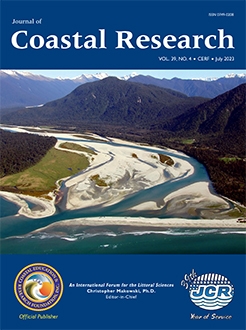Zhang, X.; Meng, J.; Sun, L., and Zhang, H., 2023. Characteristics and influencing factors of internal solitary waves in the Penghu Channel based on satellite remote sensing. Journal of Coastal Research, 39(4), 685–699. Charlotte (North Carolina), ISSN 0749-0208.
The Taiwan Strait has always been considered a hot spot for the occurrence of internal waves in the ocean. Recent research shows that the Penghu Channel also has a strong and previously unknown source of internal solitary waves (ISWs). In this paper, 23 satellite remote sensing images covering the Penghu Channel from Sentinel-1 synthetic aperture radar (SAR), Envisat advanced synthetic aperture radar, HY-1D, and GF-1 satellites are examined to reveal the sea surface characteristics of the area's ISWs through image interpretation and dynamics analysis and to study the local generation of ISWs and their evolutionary characteristics in this sea area. The results show that SE and SW cross-propagating ISWs exist in the Penghu Channel. They are generated near the Penghu Islands and the continental shelf of Taiwan at the same latitude and propagate in a countercurrent direction along the Penghu Channel. The ISWs from these two directions meet and continue to propagate southward in a V shape, with various wave–wave interactions occurring in the middle of the channel, such as Mach and resonance interactions, depending on the strength and angle characteristics of the ISWs. SAR images also show that waveform broadening occurs during the propagation of ISWs to the shallow shelf and the ISWs' polarity transition phenomenon. Although the specific generation mechanism is not clear, it is speculated that the interaction of the tidal current with the complex topography of the Penghu Channel is the main source of energy for these ISWs. In addition, the combination of drifting buoy data and analysis of hydrographic conditions in the Penghu Channel indicates that ISW phenomena on the sea surface are observed more frequently during summer flood tides with low wind speeds, low sea conditions, strong stratification, and strong currents.





